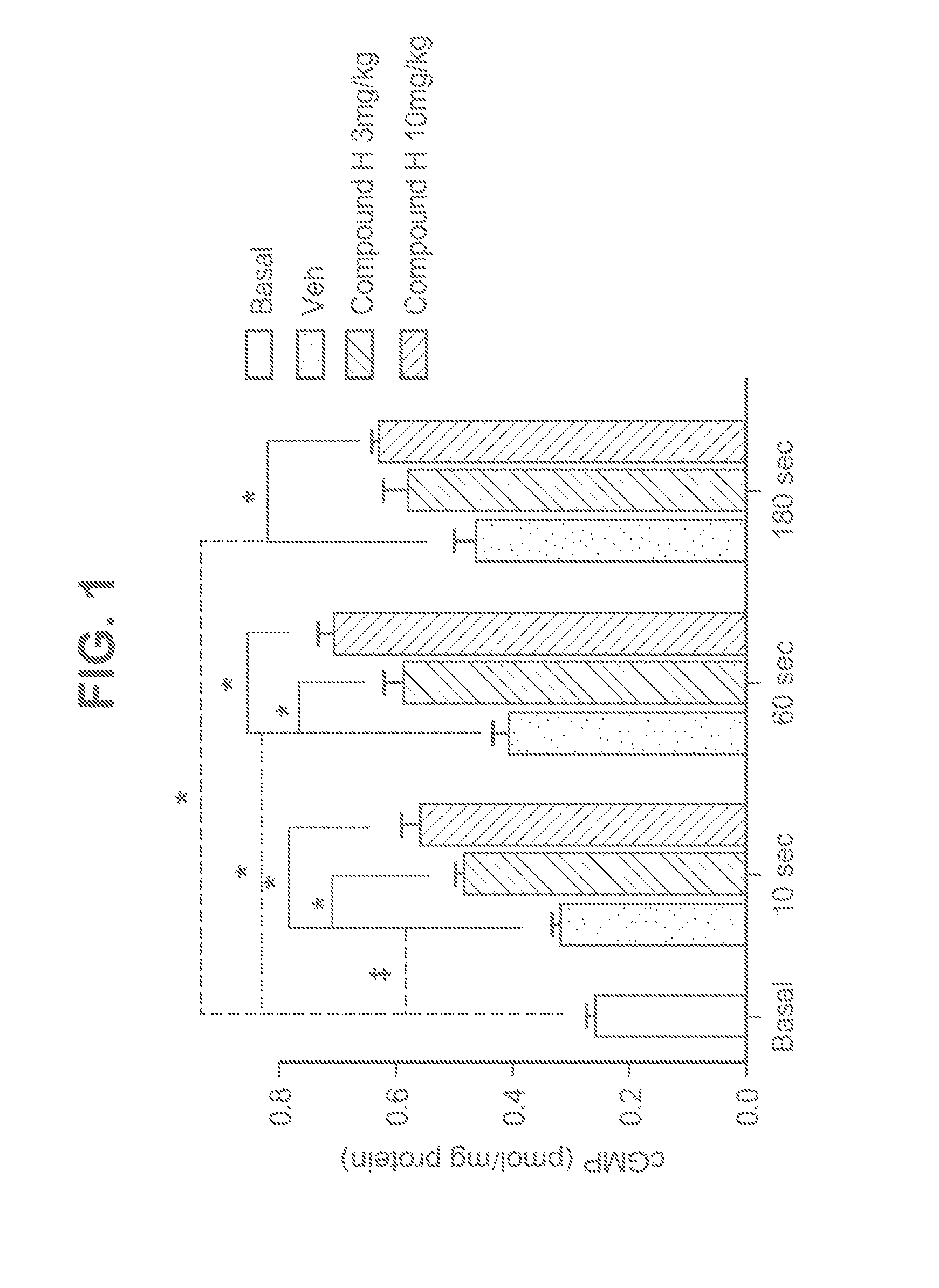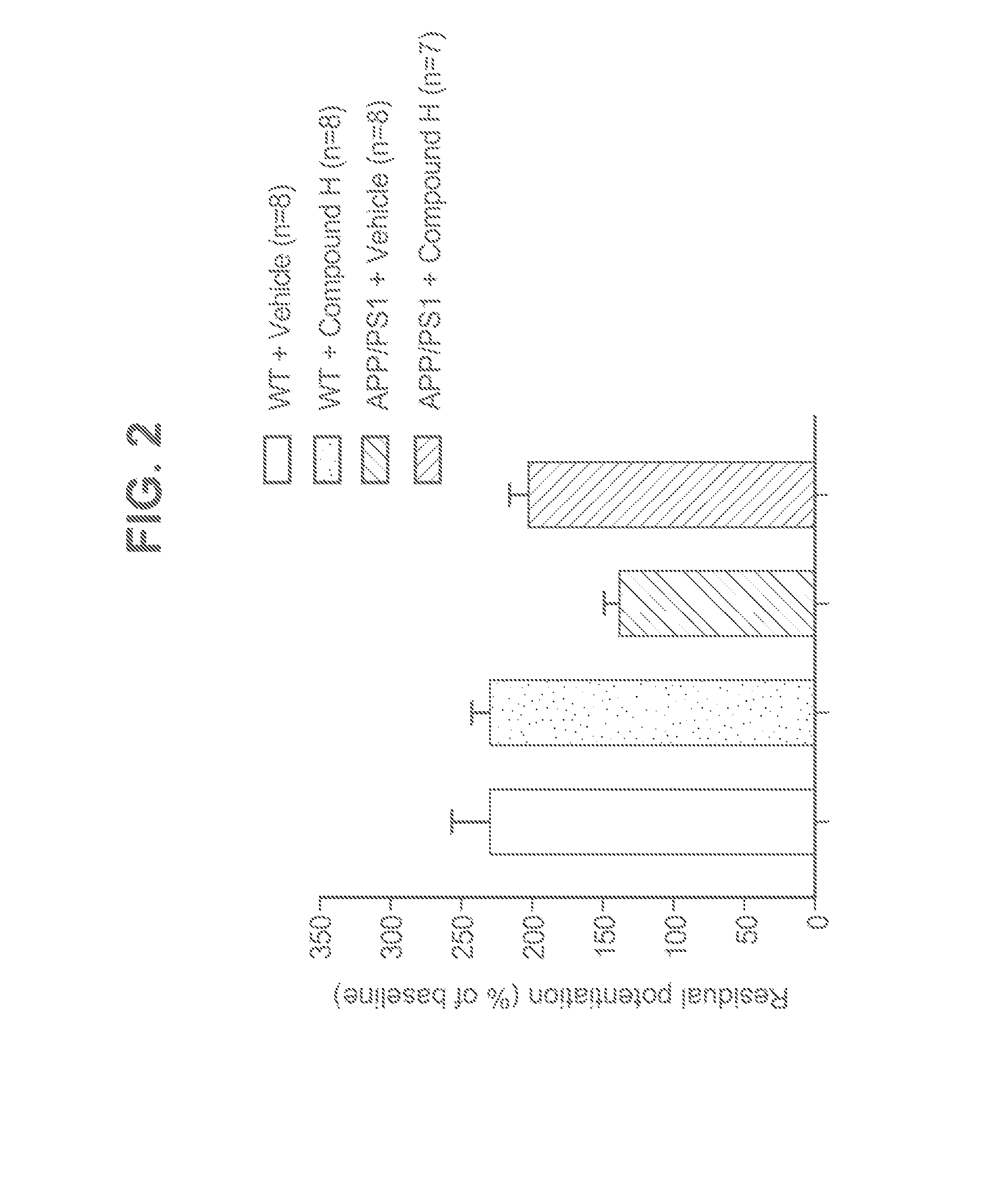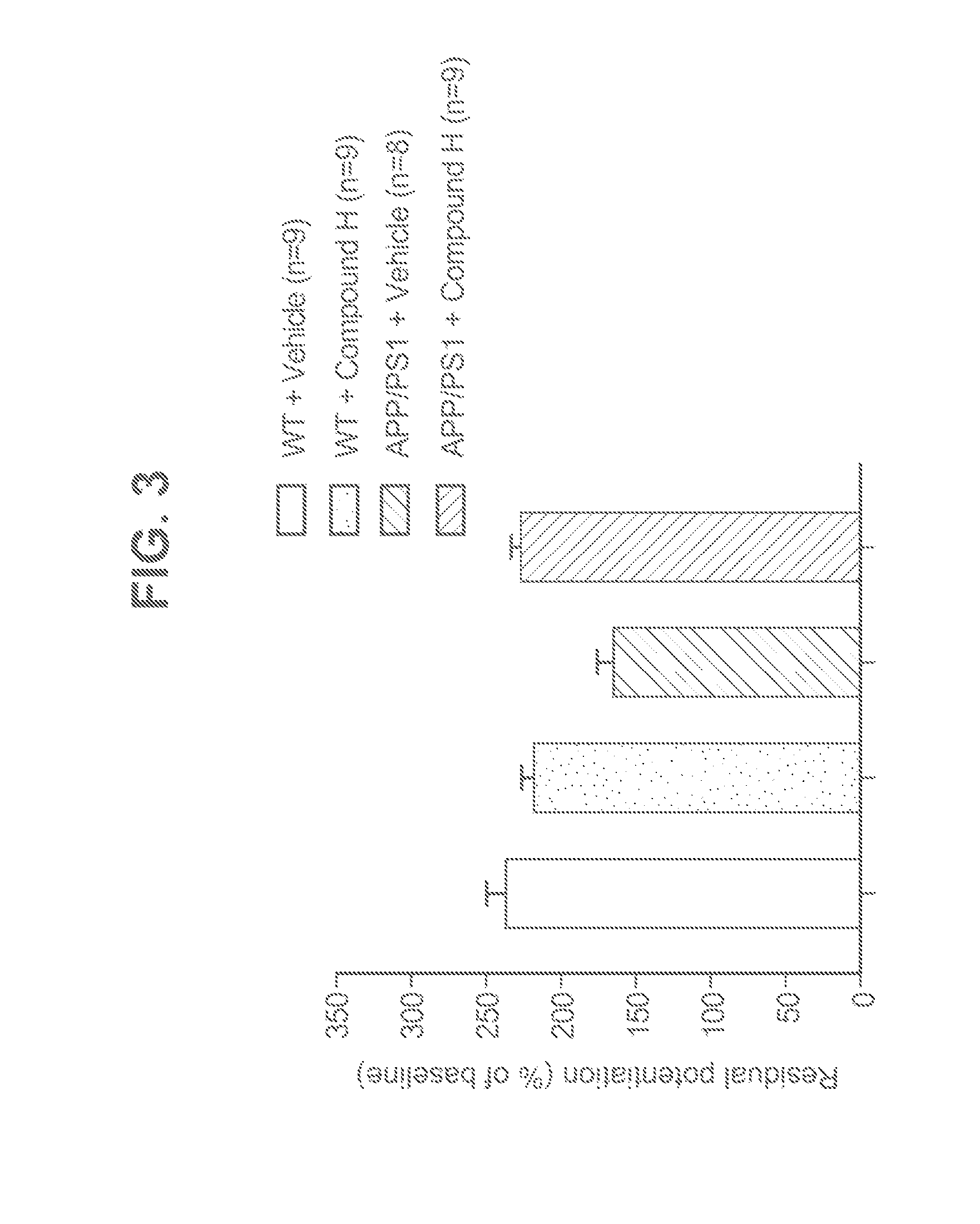Novel phosphodiesterase inhibitors and uses thereof
a phosphodiesterase inhibitor and phosphodiesterase technology, applied in the field of neurodegenerative disorders, can solve the problems of untoward side effects, current pde5 inhibitors suffer from drawbacks, limited efficacy, etc., and achieve the effects of improving synaptic function, improving memory, and increasing long-term potentiation
- Summary
- Abstract
- Description
- Claims
- Application Information
AI Technical Summary
Benefits of technology
Problems solved by technology
Method used
Image
Examples
example 1
8-bromo-N-(3-chloro-4-methoxybenzyl)-2-methyl-1,2,3,4-tetrahydrobenzo[b][1,6]naphthyridin-10-amine
[0136]
8-bromo-10-chloro-2-methyl-1,2,3,4-tetrahydrobenzo[b][1,6]naphthyridine, 2
[0137]A mixture of 1 (9.25 mmol) and 1-methylpiperidin-4-one (9.25 mmol) in POCl3 (10 mL) was heated at 60° C. for 6 h. The excess POCl3 was evaporated off; the residue was treated with iced H2O and NaHCO3 and extracted with AcOEt (3×50 mL). The organic layer was dried over Na2SO4, filtered and evaporated under reduced pressure. The desired compound was purified by triturating with Et2O (42% of yield). 1H NMR (300 MHz, CDCl3) δ 8.33 (d, 1H, J=2.1 Hz), 7.86 (d, 1H, J=9.0 Hz), 7.77 (dd, 1H, J1=2.1, J2=9.0 Hz), 3.99 (s, 2H), 3.34 (t, 2H, J=5.7 Hz), 3.03 (t, 2H, J=5.7 Hz), 2.69 (s, 3H).
[0138]A mixture of 2 (1.92 mmol), 3-chloro-4-methoxybenzylamine hydrochloride (2.11 mmol), NaI (0.1 mmol), and phenol (3.84 mmol) was heated at 130° C. for 1.5 h. After cooling the reaction down, Et2O (20 mL) was added and washed ...
example 2
10-[(3-chloro-4-methoxybenzyl)amino]-2-methyl-1,2,3,4-tetrahydrobenzo[b][1,6]naphthyridine-8-carbonitrile
[0139]
2-amino-5-cyanobenzoic acid, 3
[0140]2-amino-5-bromobenzoic acid (2.31 mmol) and CuCN (2.78 mmol) were heated to reflux in NMP (5 mL) for 3 h. The reaction mixture was poured into a solution of FeCl3 3H2O (3.0 g) in H2O (3 mL) and HCl (0.5 mL) and stirred at 60° C. for 1 h. After cooling the reaction down, Et2O (100 mL) was added and the two phases were separated. The organic layer was washed with HCl 1N (50 mL) and H2O (2×50 mL), dried over Na2SO4, filtered and evaporated under reduced pressure. 2-amino-5-cyanobenzoic acid (3) was obtained (57% of yield) by triturating from CH2Cl2.
[0141]1H NMR (300 MHz, CDCl3) δ 8.32 (d, 1H, J=1.8 Hz), 7.71 (dd, 1H, J1=1.8, J2=8.7 Hz), 7.32 (br s, 1H), 6.75 (d, 1H, J=8.7 Hz).
10-chloro-2-methyl-1,2,3,4-tetrahydrobenzo[b][1,6]naphthyridine-8-carbonitrile, 4
[0142]A mixture of 1 (1.23 mmol) and 1-methylpiperidin-4-one (1.23 mmol) in POCl3 (2 mL...
example 3
10-[(3-chloro-4-methoxybenzyl)amino]-2-ethyl-1,2,3,4-tetrahydrobenzo[b][1,6]naphthyridine-8-carbonitrile
[0145]A mixture of 5 (0.18 mmol), 3-chloro-4-methoxybenzylamine hydrochloride (0.18 mmol), NaI (0.009 mmol), and phenol (0.18 mmol) was heated at 130° C. for 2.5 h (Scheme 4). The reaction mixture was diluted with Et2O (30 mL) and washed with 1N NaOH (3×1 mL). The organic layer was dried over Na2SO4, filtered and evaporated under reduced pressure. The residue was purified by Flash Chromatography (5% MeOH in AcOEt) to give the desired compound C (38% of yield). MS ESI (m / z) 407 (M+H), 1H NMR (300 MHz, CDCl3) δ 8.32 (d, 1H, J=1.2 Hz), 7.97 (d, 1H, J=8.7 Hz), 7.71 (dd, 1H, J1=1.8, J2=8.7 Hz), 7.37 (d, 1H, J=2.1 Hz), 7.17 (dd, 1H, J1=2.1, J2=8.4 Hz), 6.94 (d, 1H, J=8.4 Hz), 4.56 (d, 2H, J=5.7 Hz), 4.12 (br s, 1H), 3.92 (s, 3H), 3.59 (s, 2H), 3.22 (t, 2H, J=6.0 Hz), 2.87 (t, 2H, J=6.0 Hz), 2.66 (q, 2H, J=7.2 Hz), 1.18 (t, 3H, J=7.2 Hz).
PUM
| Property | Measurement | Unit |
|---|---|---|
| temperature | aaaaa | aaaaa |
| temperature | aaaaa | aaaaa |
| temperature | aaaaa | aaaaa |
Abstract
Description
Claims
Application Information
 Login to View More
Login to View More - R&D
- Intellectual Property
- Life Sciences
- Materials
- Tech Scout
- Unparalleled Data Quality
- Higher Quality Content
- 60% Fewer Hallucinations
Browse by: Latest US Patents, China's latest patents, Technical Efficacy Thesaurus, Application Domain, Technology Topic, Popular Technical Reports.
© 2025 PatSnap. All rights reserved.Legal|Privacy policy|Modern Slavery Act Transparency Statement|Sitemap|About US| Contact US: help@patsnap.com



